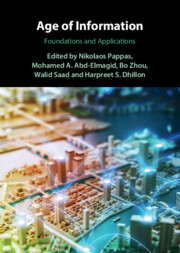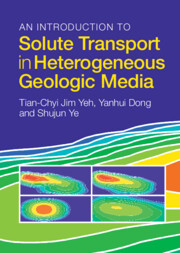Refine search
Actions for selected content:
211696 results in Engineering
Controlling the breakup of spiralling jets: results from experiments, nonlinear simulations and linear stability analysis
-
- Journal:
- Journal of Fluid Mechanics / Volume 956 / 10 February 2023
- Published online by Cambridge University Press:
- 03 February 2023, A24
-
- Article
-
- You have access
- Open access
- HTML
- Export citation

Age of Information
- Foundations and Applications
-
- Published online:
- 02 February 2023
- Print publication:
- 09 February 2023

An Introduction to Solute Transport in Heterogeneous Geologic Media
-
- Published online:
- 02 February 2023
- Print publication:
- 09 February 2023

No Miracles Needed
- How Today's Technology Can Save Our Climate and Clean Our Air
-
- Published online:
- 02 February 2023
- Print publication:
- 02 February 2023
Direct numerical simulations of turbulent pipe flow up to
 $Re_\tau \approx 5200$
$Re_\tau \approx 5200$
-
- Journal:
- Journal of Fluid Mechanics / Volume 956 / 10 February 2023
- Published online by Cambridge University Press:
- 02 February 2023, A18
-
- Article
-
- You have access
- Open access
- HTML
- Export citation
17 - Machine Learning for Turbulence Control
- from Part V - Applications
-
-
- Book:
- Data-Driven Fluid Mechanics
- Published online:
- 12 January 2023
- Print publication:
- 02 February 2023, pp 350-367
-
- Chapter
- Export citation
12 - Methods for System Identification
- from Part IV - Dynamical Systems
-
-
- Book:
- Data-Driven Fluid Mechanics
- Published online:
- 12 January 2023
- Print publication:
- 02 February 2023, pp 232-254
-
- Chapter
- Export citation
8 - Generalized and Multiscale Modal Analysis
- from Part III - Data-Driven Decompositions
-
-
- Book:
- Data-Driven Fluid Mechanics
- Published online:
- 12 January 2023
- Print publication:
- 02 February 2023, pp 153-181
-
- Chapter
- Export citation
2 - WWS Solutions for Electricity Generation
-
- Book:
- No Miracles Needed
- Published online:
- 02 February 2023
- Print publication:
- 02 February 2023, pp 20-34
-
- Chapter
- Export citation
13 - Modern Tools for the Stability Analysis of Fluid Flows
- from Part IV - Dynamical Systems
-
-
- Book:
- Data-Driven Fluid Mechanics
- Published online:
- 12 January 2023
- Print publication:
- 02 February 2023, pp 255-284
-
- Chapter
- Export citation
12 - Steps in Developing 100 Percent WWS Roadmaps
-
- Book:
- No Miracles Needed
- Published online:
- 02 February 2023
- Print publication:
- 02 February 2023, pp 261-278
-
- Chapter
- Export citation
15 - Advancing Reacting Flow Simulations with Data-Driven Models
- from Part V - Applications
-
-
- Book:
- Data-Driven Fluid Mechanics
- Published online:
- 12 January 2023
- Print publication:
- 02 February 2023, pp 304-329
-
- Chapter
- Export citation
Multiphase segmentation of digital material images
-
- Journal:
- Data-Centric Engineering / Volume 4 / 2023
- Published online by Cambridge University Press:
- 02 February 2023, e5
-
- Article
-
- You have access
- Open access
- HTML
- Export citation
8 - What Doesn’t Work
-
- Book:
- No Miracles Needed
- Published online:
- 02 February 2023
- Print publication:
- 02 February 2023, pp 129-191
-
- Chapter
- Export citation
References
-
- Book:
- No Miracles Needed
- Published online:
- 02 February 2023
- Print publication:
- 02 February 2023, pp 384-412
-
- Chapter
- Export citation
Contents
-
- Book:
- No Miracles Needed
- Published online:
- 02 February 2023
- Print publication:
- 02 February 2023, pp vii-viii
-
- Chapter
- Export citation
Preface
-
- Book:
- Data-Driven Fluid Mechanics
- Published online:
- 12 January 2023
- Print publication:
- 02 February 2023, pp xiii-xviii
-
- Chapter
- Export citation
Index
-
- Book:
- No Miracles Needed
- Published online:
- 02 February 2023
- Print publication:
- 02 February 2023, pp 413-437
-
- Chapter
- Export citation
A Note on the Notation
-
- Book:
- Data-Driven Fluid Mechanics
- Published online:
- 12 January 2023
- Print publication:
- 02 February 2023, pp xix-xx
-
- Chapter
- Export citation
Reviews
-
- Book:
- No Miracles Needed
- Published online:
- 02 February 2023
- Print publication:
- 02 February 2023, pp ii-ii
-
- Chapter
- Export citation


















